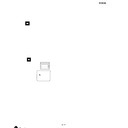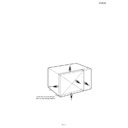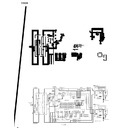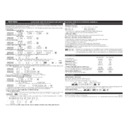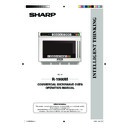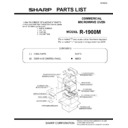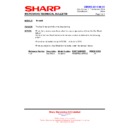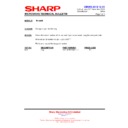Sharp R-1900M (serv.man8) Service Manual ▷ View online
R1900M
7 – 5
For example: Procedure to set standard voltage at 230V(230V
±1V) area.
6. CUSTOM HELP
You can check if the correct control unit is installed or not by using this function.
Procedure to check the model name and making date of software.
#1: The display will show “cd19”.
“cd19” means model R-1900M.
Operation
Display
Indicator
Sound
(within 20 sec.)
(within 20 sec.)
plug in
POWER LEVEL
SET MEMORY
START
STOP/CLEAR
7
START
(after 1 sec.)
STOP/CLEAR
.
.
.
.
.
SF-
230U
230U
230U
SF-
0
Flashing
Operation
Display
Indicator
Sound
(within 20 sec.)
POWER LEVEL
SET MEMORY
START
STOP/CLEAR
CUSTOM
STOP/CLEAR
plug in
.
.
.
.
.
.
SF-
cd-XX
XXXX
XXXX
0
(within 20 sec.)
#1
(model name)
(date)
(time)
R1900M
7 – 6
[2] SERVICING FOR BRINTED WIRING BOARDS
1. Precautions for Handling Electronic Components
This unit uses CMOS LSI in the integral part of the circuits. When han-
dling these parts, the following precautions should be strictly followed.
CMOS LSI have extremely high impedance at its input and output ter-
minals. For this reason, it is easily influenced by the surrounding high
voltage power source, static electricity charge in clothes, etc. and
sometimes it is not fully protected by the built-in protection circuit.
dling these parts, the following precautions should be strictly followed.
CMOS LSI have extremely high impedance at its input and output ter-
minals. For this reason, it is easily influenced by the surrounding high
voltage power source, static electricity charge in clothes, etc. and
sometimes it is not fully protected by the built-in protection circuit.
In order to protect CMOS LSI.
1) When storing and transporting, thoroughly wrap them in aluminium
foil. Also wrap PW boards containing them in aluminium foil.
2) When soldering, ground the technician as shown in the figure and
use grounded soldering iron and work table.
2. Servicing of Printed Wiring Boards
We describe the procedures to permit servicing of the printed wiring
boards of the microwave oven and the precautions you must take
when doing so. To perform the servicing, power to the printed wiring
boards is available either from the power line of the oven itself or from
an external power source.
boards of the microwave oven and the precautions you must take
when doing so. To perform the servicing, power to the printed wiring
boards is available either from the power line of the oven itself or from
an external power source.
1. Servicing the printed wiring boards with power supply of the
oven:
CAUTION: THE POWER TRANSFORMER OF THE MICROWAVE
OVEN IS STILL LIVE DURING SERVICING AND PRE-
SENTS A HAZARD.
SENTS A HAZARD.
Therefore, before checking the performance of the printed wiring
boards,
boards,
1) Disconnect the power supply cord and then remove outer case
and rear cover.
2) Open the door and block it open.
3) Discharge two high voltage capacitors.
4) Disconnect the leads to the primary of the two power transform-
ers.
5) Ensure that these leads remain isolated from other components
and oven chassis by using insulation tape.
6) After that procedure, re-connect the power supply cord.
After checking the performance of the printed wiring boards,
1) Disconnect the power supply cord.
2) Open the door and block it open.
3) Re-connect the leads to the primary of the two power transform-
ers.
4) Re-install the rear cover and the outer case (cabinet).
5) Re-connect the power supply cord after the rear cover and the
outer case is installed.
6) Run the oven and check all functions.
a) On some models, the power supply cord between the printed
wiring boards and the oven itself is so short that the they
can’t be separated. For those models, check and repair all
the printed wiring boards (sensor-related ones included) of
the printed wiring boards while keeping it connected to the
oven.
can’t be separated. For those models, check and repair all
the printed wiring boards (sensor-related ones included) of
the printed wiring boards while keeping it connected to the
oven.
b) On some models, the power supply cord between the printed
wiring boards and the oven proper is long enough that they
may be separated from each other. For those models, it is
possible to check and repair the controls of the printed wiring
boards while keeping it apart from the oven proper; in this
case you must short both ends of the door sensing switch
(on PWB) of the printed wiring boards with a jumper, which
activates an operational state that is equivalent to the oven
door being closed. As for the sensor-related controls of the
printed wiring boards, checking them is possible if dummy
resistor(s) with resistance equal to that of the controls are
used.
may be separated from each other. For those models, it is
possible to check and repair the controls of the printed wiring
boards while keeping it apart from the oven proper; in this
case you must short both ends of the door sensing switch
(on PWB) of the printed wiring boards with a jumper, which
activates an operational state that is equivalent to the oven
door being closed. As for the sensor-related controls of the
printed wiring boards, checking them is possible if dummy
resistor(s) with resistance equal to that of the controls are
used.
2. Servicing the printed wiring boards with power supply from an
external power source:
Disconnect the printed wiring boards completely from the oven
proper, and short both ends of the door sensing switch (on PWB) of
the printed wiring boards, which activates an operational state that
is equivalent to the oven door being closed. Connect an external
power source to the power input terminal of the printed wiring
boards, then it is possible to check and repair the controls of the
printed wiring boards it is also possible to check the sensor-related
controls of the printed wiring boards by using the dummy resis-
tor(s).
proper, and short both ends of the door sensing switch (on PWB) of
the printed wiring boards, which activates an operational state that
is equivalent to the oven door being closed. Connect an external
power source to the power input terminal of the printed wiring
boards, then it is possible to check and repair the controls of the
printed wiring boards it is also possible to check the sensor-related
controls of the printed wiring boards by using the dummy resis-
tor(s).
3. Servicing Tools
Tools required to service the printed wiring boards assembly.
1) Soldering iron: 60W
(It is recommended to use a soldering iron with a grounding termi-
nal.)
nal.)
2) Oscilloscope: Single beam, frequency range: DC - 10MHz type or
more advanced model.
3) Others: Hand tools
4. Other Precautions
1) Before turning on the power source of the printed wiring boards,
remove the aluminium foil applied for preventing static electricity.
2) Connect the connector of the key unit to the printed wiring boards
being sure that the lead wires are not twisted.
3) After aluminium foil is removed, be careful that abnormal voltage
due to static electricity etc. is not applied to the input or output ter-
minals.
minals.
4) Attach connectors, electrolytic capacitors, etc. to PWB, making
sure that all connections are tight.
5) Be sure to use specified components where high precision is
required.
approx. 1M ohm
R1900M
7 – 6
[2] SERVICING FOR BRINTED WIRING BOARDS
1. Precautions for Handling Electronic Components
This unit uses CMOS LSI in the integral part of the circuits. When han-
dling these parts, the following precautions should be strictly followed.
CMOS LSI have extremely high impedance at its input and output ter-
minals. For this reason, it is easily influenced by the surrounding high
voltage power source, static electricity charge in clothes, etc. and
sometimes it is not fully protected by the built-in protection circuit.
dling these parts, the following precautions should be strictly followed.
CMOS LSI have extremely high impedance at its input and output ter-
minals. For this reason, it is easily influenced by the surrounding high
voltage power source, static electricity charge in clothes, etc. and
sometimes it is not fully protected by the built-in protection circuit.
In order to protect CMOS LSI.
1) When storing and transporting, thoroughly wrap them in aluminium
foil. Also wrap PW boards containing them in aluminium foil.
2) When soldering, ground the technician as shown in the figure and
use grounded soldering iron and work table.
2. Servicing of Printed Wiring Boards
We describe the procedures to permit servicing of the printed wiring
boards of the microwave oven and the precautions you must take
when doing so. To perform the servicing, power to the printed wiring
boards is available either from the power line of the oven itself or from
an external power source.
boards of the microwave oven and the precautions you must take
when doing so. To perform the servicing, power to the printed wiring
boards is available either from the power line of the oven itself or from
an external power source.
1. Servicing the printed wiring boards with power supply of the
oven:
CAUTION: THE POWER TRANSFORMER OF THE MICROWAVE
OVEN IS STILL LIVE DURING SERVICING AND PRE-
SENTS A HAZARD.
SENTS A HAZARD.
Therefore, before checking the performance of the printed wiring
boards,
boards,
1) Disconnect the power supply cord and then remove outer case
and rear cover.
2) Open the door and block it open.
3) Discharge two high voltage capacitors.
4) Disconnect the leads to the primary of the two power transform-
ers.
5) Ensure that these leads remain isolated from other components
and oven chassis by using insulation tape.
6) After that procedure, re-connect the power supply cord.
After checking the performance of the printed wiring boards,
1) Disconnect the power supply cord.
2) Open the door and block it open.
3) Re-connect the leads to the primary of the two power transform-
ers.
4) Re-install the rear cover and the outer case (cabinet).
5) Re-connect the power supply cord after the rear cover and the
outer case is installed.
6) Run the oven and check all functions.
a) On some models, the power supply cord between the printed
wiring boards and the oven itself is so short that the they
can’t be separated. For those models, check and repair all
the printed wiring boards (sensor-related ones included) of
the printed wiring boards while keeping it connected to the
oven.
can’t be separated. For those models, check and repair all
the printed wiring boards (sensor-related ones included) of
the printed wiring boards while keeping it connected to the
oven.
b) On some models, the power supply cord between the printed
wiring boards and the oven proper is long enough that they
may be separated from each other. For those models, it is
possible to check and repair the controls of the printed wiring
boards while keeping it apart from the oven proper; in this
case you must short both ends of the door sensing switch
(on PWB) of the printed wiring boards with a jumper, which
activates an operational state that is equivalent to the oven
door being closed. As for the sensor-related controls of the
printed wiring boards, checking them is possible if dummy
resistor(s) with resistance equal to that of the controls are
used.
may be separated from each other. For those models, it is
possible to check and repair the controls of the printed wiring
boards while keeping it apart from the oven proper; in this
case you must short both ends of the door sensing switch
(on PWB) of the printed wiring boards with a jumper, which
activates an operational state that is equivalent to the oven
door being closed. As for the sensor-related controls of the
printed wiring boards, checking them is possible if dummy
resistor(s) with resistance equal to that of the controls are
used.
2. Servicing the printed wiring boards with power supply from an
external power source:
Disconnect the printed wiring boards completely from the oven
proper, and short both ends of the door sensing switch (on PWB) of
the printed wiring boards, which activates an operational state that
is equivalent to the oven door being closed. Connect an external
power source to the power input terminal of the printed wiring
boards, then it is possible to check and repair the controls of the
printed wiring boards it is also possible to check the sensor-related
controls of the printed wiring boards by using the dummy resis-
tor(s).
proper, and short both ends of the door sensing switch (on PWB) of
the printed wiring boards, which activates an operational state that
is equivalent to the oven door being closed. Connect an external
power source to the power input terminal of the printed wiring
boards, then it is possible to check and repair the controls of the
printed wiring boards it is also possible to check the sensor-related
controls of the printed wiring boards by using the dummy resis-
tor(s).
3. Servicing Tools
Tools required to service the printed wiring boards assembly.
1) Soldering iron: 60W
(It is recommended to use a soldering iron with a grounding termi-
nal.)
nal.)
2) Oscilloscope: Single beam, frequency range: DC - 10MHz type or
more advanced model.
3) Others: Hand tools
4. Other Precautions
1) Before turning on the power source of the printed wiring boards,
remove the aluminium foil applied for preventing static electricity.
2) Connect the connector of the key unit to the printed wiring boards
being sure that the lead wires are not twisted.
3) After aluminium foil is removed, be careful that abnormal voltage
due to static electricity etc. is not applied to the input or output ter-
minals.
minals.
4) Attach connectors, electrolytic capacitors, etc. to PWB, making
sure that all connections are tight.
5) Be sure to use specified components where high precision is
required.
approx. 1M ohm
R1900M
7 – 6
[2] SERVICING FOR BRINTED WIRING BOARDS
1. Precautions for Handling Electronic Components
This unit uses CMOS LSI in the integral part of the circuits. When han-
dling these parts, the following precautions should be strictly followed.
CMOS LSI have extremely high impedance at its input and output ter-
minals. For this reason, it is easily influenced by the surrounding high
voltage power source, static electricity charge in clothes, etc. and
sometimes it is not fully protected by the built-in protection circuit.
dling these parts, the following precautions should be strictly followed.
CMOS LSI have extremely high impedance at its input and output ter-
minals. For this reason, it is easily influenced by the surrounding high
voltage power source, static electricity charge in clothes, etc. and
sometimes it is not fully protected by the built-in protection circuit.
In order to protect CMOS LSI.
1) When storing and transporting, thoroughly wrap them in aluminium
foil. Also wrap PW boards containing them in aluminium foil.
2) When soldering, ground the technician as shown in the figure and
use grounded soldering iron and work table.
2. Servicing of Printed Wiring Boards
We describe the procedures to permit servicing of the printed wiring
boards of the microwave oven and the precautions you must take
when doing so. To perform the servicing, power to the printed wiring
boards is available either from the power line of the oven itself or from
an external power source.
boards of the microwave oven and the precautions you must take
when doing so. To perform the servicing, power to the printed wiring
boards is available either from the power line of the oven itself or from
an external power source.
1. Servicing the printed wiring boards with power supply of the
oven:
CAUTION: THE POWER TRANSFORMER OF THE MICROWAVE
OVEN IS STILL LIVE DURING SERVICING AND PRE-
SENTS A HAZARD.
SENTS A HAZARD.
Therefore, before checking the performance of the printed wiring
boards,
boards,
1) Disconnect the power supply cord and then remove outer case
and rear cover.
2) Open the door and block it open.
3) Discharge two high voltage capacitors.
4) Disconnect the leads to the primary of the two power transform-
ers.
5) Ensure that these leads remain isolated from other components
and oven chassis by using insulation tape.
6) After that procedure, re-connect the power supply cord.
After checking the performance of the printed wiring boards,
1) Disconnect the power supply cord.
2) Open the door and block it open.
3) Re-connect the leads to the primary of the two power transform-
ers.
4) Re-install the rear cover and the outer case (cabinet).
5) Re-connect the power supply cord after the rear cover and the
outer case is installed.
6) Run the oven and check all functions.
a) On some models, the power supply cord between the printed
wiring boards and the oven itself is so short that the they
can’t be separated. For those models, check and repair all
the printed wiring boards (sensor-related ones included) of
the printed wiring boards while keeping it connected to the
oven.
can’t be separated. For those models, check and repair all
the printed wiring boards (sensor-related ones included) of
the printed wiring boards while keeping it connected to the
oven.
b) On some models, the power supply cord between the printed
wiring boards and the oven proper is long enough that they
may be separated from each other. For those models, it is
possible to check and repair the controls of the printed wiring
boards while keeping it apart from the oven proper; in this
case you must short both ends of the door sensing switch
(on PWB) of the printed wiring boards with a jumper, which
activates an operational state that is equivalent to the oven
door being closed. As for the sensor-related controls of the
printed wiring boards, checking them is possible if dummy
resistor(s) with resistance equal to that of the controls are
used.
may be separated from each other. For those models, it is
possible to check and repair the controls of the printed wiring
boards while keeping it apart from the oven proper; in this
case you must short both ends of the door sensing switch
(on PWB) of the printed wiring boards with a jumper, which
activates an operational state that is equivalent to the oven
door being closed. As for the sensor-related controls of the
printed wiring boards, checking them is possible if dummy
resistor(s) with resistance equal to that of the controls are
used.
2. Servicing the printed wiring boards with power supply from an
external power source:
Disconnect the printed wiring boards completely from the oven
proper, and short both ends of the door sensing switch (on PWB) of
the printed wiring boards, which activates an operational state that
is equivalent to the oven door being closed. Connect an external
power source to the power input terminal of the printed wiring
boards, then it is possible to check and repair the controls of the
printed wiring boards it is also possible to check the sensor-related
controls of the printed wiring boards by using the dummy resis-
tor(s).
proper, and short both ends of the door sensing switch (on PWB) of
the printed wiring boards, which activates an operational state that
is equivalent to the oven door being closed. Connect an external
power source to the power input terminal of the printed wiring
boards, then it is possible to check and repair the controls of the
printed wiring boards it is also possible to check the sensor-related
controls of the printed wiring boards by using the dummy resis-
tor(s).
3. Servicing Tools
Tools required to service the printed wiring boards assembly.
1) Soldering iron: 60W
(It is recommended to use a soldering iron with a grounding termi-
nal.)
nal.)
2) Oscilloscope: Single beam, frequency range: DC - 10MHz type or
more advanced model.
3) Others: Hand tools
4. Other Precautions
1) Before turning on the power source of the printed wiring boards,
remove the aluminium foil applied for preventing static electricity.
2) Connect the connector of the key unit to the printed wiring boards
being sure that the lead wires are not twisted.
3) After aluminium foil is removed, be careful that abnormal voltage
due to static electricity etc. is not applied to the input or output ter-
minals.
minals.
4) Attach connectors, electrolytic capacitors, etc. to PWB, making
sure that all connections are tight.
5) Be sure to use specified components where high precision is
required.
approx. 1M ohm
Display




